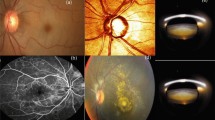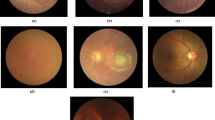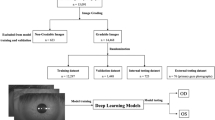Abstract
It is necessary to manually measure many parameters of eyes when an ophthalmologist diagnoses, which is time consuming, unsanitary, subjective and unrepeatable. Those manually achieved parameters often risk clinical trials in challenges on objectivity, resulting in unreliable clinical conclusions. We designed a two-phase algorithm to automatically measure these parameters instead of manual measurement to facilitate the diagnosis procedure of ptosis, eyelid retraction and other eye pathologies. Firstly, cornea, sclera, and internal and external canthus were identified using a multi-task convolutional neural network (CNN). Then we used the identification results to calculate a series of eye parameters needed in clinic. Totally 9 widely accepted parameters were calculated, including the height of ocular fissure, the longitudinal and transverse diameters of cornea, etc. The experimental results showed that most of parameters had achieved good accuracy, and most errors were less than 2 mm. We found that our approach can improve the measurements accuracy of eyelid, conjunctiva, cornea, sclera, and internal and external canthus, and promote efficiency and efficacy of relative clinical researches.













Similar content being viewed by others
References
Abate AF, Frucci M, Galdi C, Riccio D (2015) BIRD: watershed based iris detection for mobile devices. Pattern Recogn Lett 57:43–51. https://doi.org/10.1016/j.patrec.2014.10.017
Badrinarayanan V, Kendall A, Cipolla R (2017) Segnet: a deep convolutional encoder-decoder architecture for image segmentation. IEEE Trans Pattern Analysis and Machine Intelligence 39(12):2481–2495. https://doi.org/10.1109/tpami.2016.2644615
Boles WW, Boashash B (1998) A human identification technique using images of the iris and wavelet transform. IEEE Trans Signal Processing 46(4):1185–1188. https://doi.org/10.1109/78.668573
Castro A, Benito A, Manzanera S et al (2018) Three-dimensional cataract crystalline lens imaging with swept-source optical coherence tomography. Investigative Ophthalmology Visual Science 59:897–903. https://doi.org/10.1167/iovs.17-23596
Chen C, Ross A (2018) A multi-task convolutional neural network for joint iris detection and presentation attack detection. IEEE Winter Applications of Computer Vision Workshops, pp:44–51. https://doi.org/10.1109/WACVW.2018.00011
Chen LC, Papandreou G, Kokkinos I, Murphy K, Yuille AL (2017) Deeplab: semantic image segmentation with deep convolutional nets, atrous convolution, and fully connected crfs. IEEE Trans. Pattern Analysis and Machine Intelligence 40(4):834–848. https://doi.org/10.1109/TPAMI.2017.2699184
Das A, Pal U, Ferrer MA et al (2016) SSRBC 2016: sclera segmentation and recognition benchmarking competition. Int. Conf. Biometrics, pp 1–6. https://doi.org/10.1109/ICB.2016.7550069
Das S, De Ghosh I, Chattopadhyay A (2020) An efficient deep learning strategy: its application in sclera segmentation. IEEE Applied Signal Processing Conference, pp 232–236. https://doi.org/10.1109/ASPCON49795.2020.9276718
Daugman JG (1993) High confidence visual recognition of persons by a test of statistical independence. IEEE Trans. Pattern Analysis and Machine Intelligence 15(11):1148–1161. https://doi.org/10.1109/34.244676
Daugman J (2004) How iris recognition works. IEEE Trans Circuits and Systems for Video Technology 14(1):21–30. https://doi.org/10.1016/B978-0-12-374457-9.00025-1
Daugman J (2007) New methods in iris recognition. IEEE trans. Systems Man Cybernetics, Part B (Cybernetics) 37(5):1167–1175. https://doi.org/10.1109/TSMCB.2007.903540
De Marsico M, Nappi M, Riccio D et al (2015) Mobile iris challenge evaluation (miche)-i, biometric iris dataset and protocols. Pattern Recogn Lett 57:17–23. https://doi.org/10.1016/j.patrec.2015.02.009
Gao X, Lin S, Wong TY (2015) Automatic feature learning to grade nuclear cataracts based on deep learning. IEEE trans. Biomed Eng 62:2693–2701. https://doi.org/10.1109/TBME.2015.2444389
Gulshan V, Peng L, Coram M, Stumpe MC, Wu D, Narayanaswamy A, Venugopalan S, Widner K, Madams T, Cuadros J, Kim R, Raman R, Nelson PC, Mega JL, Webster DR (2016) Development and validation of a deep learning algorithm for detection of diabetic retinopathy in retinal fundus photographs. Jama 316(22):2402–2410. https://doi.org/10.1001/jama.2016.17216
Jayanthi J, Lydia EL, Krishnaraj N, Jayasankar T, Babu RL, Suji RA (2020) An effective deep learning features based integrated framework for iris detection and recognition. Journal of ambient intelligence and humanized computing, pp 1-11. 12:3271–3281. https://doi.org/10.1007/s12652-020-02172-y
Kerrigan D, Trokielewicz M, Czajka A et al (2019) Iris recognition with image segmentation employing retrained off-the-shelf deep neural networks. Int. Conf. Biometrics, pp 1–7. https://doi.org/10.1109/ICB45273.2019.8987299
Li Y, Yuan L, Vasconcelos N (2019) Bidirectional learning for domain adaptation of semantic segmentation. Proc. IEEE Conf. Computer Vision and Pattern Recognition, pp 6936–6945. https://doi.org/10.1109/CVPR.2019.00710
Litjens G, Kooi T, Bejnordi BE, Setio AAA, Ciompi F, Ghafoorian M, van der Laak JAWM, van Ginneken B, Sánchez CI (2017) A survey on deep learning in medical image analysis. Med Image Anal 42(9):60–88. https://doi.org/10.1016/j.media.2017.07.005
Liu W, Anguelov D, Erhan D et al (2016) SSD: single shot multibox detector. European Conf. Computer Vision, pp 21–37
Liu L, Ouyang W, Wang X, Fieguth P, Chen J, Liu X, Pietikäinen M (2020) Deep learning for generic object detection: a survey. Int J Comput Vis 128:261–318. https://doi.org/10.1007/s11263-019-01247-4
Long J, Shelhamer E, Darrell T (2015) Fully convolutional networks for semantic segmentation. Proc. IEEE Conf. Computer Vision and Pattern Recognition, pp 3431–3440
Lucio DR, Laroca R, Severo E et al (2018) Fully connected networks and generative neural networks applied to sclera segmentation. Int. Conf. Biometrics Theory, Applications and Systems, Redondo Beach, CA, USA, pp. 1–7. https://doi.org/10.1109/BTAS.2018.8698597
Mark J, Grinsven V, Ginneken BV et al (2016) Fast convolutional neural network training using selective data sampling: application to hemorrhage detection in colour fundus images. IEEE Trans Medical Imaging 35(5):1273–1284. https://doi.org/10.1109/TMI.2016.2526689
Marku N, Frljak M, Pandi IS et al (2014) Eye pupil localization with an ensemble of randomized trees. Pattern Recogn 47(2):578–587. https://doi.org/10.1016/j.patcog.2013.08.008
Radu P, Ferryman J, Wild P (2015) A robust sclera segmentation algorithm. Proc. IEEE Int. Conf. Biometrics Theory, Applications and Systems, Arlington, USA, pp. 1–6. https://doi.org/10.1109/BTAS.2015.7358746
Redmon J, Farhadi A (2017) YOLO9000: better, faster, stronger. Proc. IEEE Conf. Computer Vision and Pattern Recognition, pp 7263–7271
Redmon J, Farhadi A (2018) Yolov3: An incremental improvement. arXiv preprint arXiv:1804.02767.
Redmon J, Divvala S, Girshick R et al (2016) You only look once: unified, real-time object detection. IEEE Conf. Computer Vision and Pattern Recognition, LAS VEGAS, USA, pp. 779–788.
Ronneberger O, Fischer P, Brox T (2015) U-net: convolutional networks for biomedical image segmentation. Int. Conf. Medical image computing and computer-assisted intervention, Munich, Germany, pp 234-241.https://doi.org/10.1007/978-3-319-24574-4_28
Rot P, Vitek M, Grm K et al (2020) Deep sclera segmentation and recognition. Handbook of vascular biometrics. Springer, pp 395–432
Setio A, Ciompi F, Litjens G et al (2016) Pulmonary nodule detection in CT images: false positive reduction using multi-view convolutional networks. IEEE Trans. Medical Imaging 35(5):1160–1169. https://doi.org/10.1109/TMI.2016.2536809
Severo E, Laroca R, Bezerra C et al (2018) A benchmark for iris location and a deep learning detector evaluation. Int. Jo. Conf. Neural Networks, pp 1–7. https://doi.org/10.1109/IJCNN.2018.8489638
Susitha N, Subban R (2019) Reliable pupil detection and iris segmentation algorithm based on SPS. Cogn Syst Res 57:78–84. https://doi.org/10.1016/j.cogsys.2018.09.029
Thakker MM, Rubin PA (2002) Mechanisms of acquired blepharoptosis. Ophthalmol Clin N Am 15(1):101–111. https://doi.org/10.1016/s0896-1549(01)00005-0
Tian Z, Shen C, Chen H et al (2019) FCOS: fully convolutional one-stage object detection. Proc. Int. Conf. Computer Vision, pp 9627–9636. https://doi.org/10.1109/ICCV.2019.00972
Wang C, Zhu Y, Liu Y, et al (2019) Joint iris segmentation and localization using deep multi-task learning framework. arXiv preprint arXiv:1901.11195.
Wang C , He Y , Liu Y , et al (2019) ScleraSegNet: an improved U-net model with attention for accurate sclera segmentation. The 12th IAPR Int. Conf. Biometrics, Crete, Greece, pp 1-8. https://doi.org/10.1109/ICB45273.2019.8987270
Wood E, Baltrušaitis T, Morency LP et al (2016) Learning an appearance-based gaze estimator from one million synthesised images. Proc. Ninth Biennial ACM Symposium on Eye Tracking Research & Applications, pp 131–138. https://doi.org/10.1145/2857491.2857492
Yang P, Du B, Shan S et al (2004) A novel pupil localization method based on gaboreye model and radial symmetry operator. Int. Conf. Image Processing, Singapore 1:67–70. https://doi.org/10.1109/ICIP.2004.1418691
Yuille AL, Hallinan PW, Cohen DS (1992) Feature extraction from faces using deformable templates. Int J Comput Vis 8(2):99–111. https://doi.org/10.1109/CVPR.1989.37836
Zhou E, Fan H, Cao Z et al (2013) Extensive facial landmark localization with coarse-to-fine convolutional network Cascade. Proc. Int. Conf. Computer Vision Workshops, pp 386–391. https://doi.org/10.1109/ICCVW.2013.58
Author information
Authors and Affiliations
Corresponding author
Additional information
Publisher’s note
Springer Nature remains neutral with regard to jurisdictional claims in published maps and institutional affiliations.
Rights and permissions
About this article
Cite this article
Zhu, X., Song, X., Min, X. et al. Calculation of ophthalmic diagnostic parameters on a single eye image based on deep neural network. Multimed Tools Appl 81, 2311–2331 (2022). https://doi.org/10.1007/s11042-021-11047-z
Received:
Revised:
Accepted:
Published:
Issue Date:
DOI: https://doi.org/10.1007/s11042-021-11047-z




